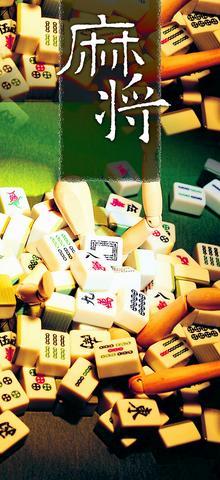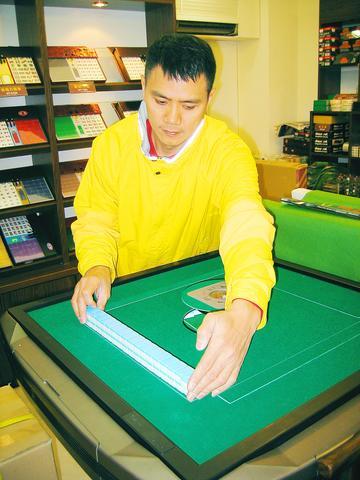It's the time of year when the clatter of plastic tiles on wooden tables reverberates throughout apartment blocks nationwide, as families gather to enjoy each other's company and family members attempt to take their relatives for as much money as they can at the mahjong table.
While a lot quieter than a noisy neighbor's Lunar New Year KTV party, those with little interest in the game may be irritated by the constant clanking. For those with mahjong smarts, however, the Lunar New Year is a time to savor. After all, what could be more pleasurable than sitting immobile at a square table from between eight hours to three days smoking, drinking, chatting and gambling?

"New Year is great time for anyone who likes mahjong. You get to be with your family, eat well and, of course, play plenty of games," said Chen Chuan-fu (陳俊福), proprietor of Oriental Undefeated (東方敗), one of Taipei's leading mahjong stores. "You smoke, you drink and -- since it's the New Year -- people have extra cash in their pockets so the ante is always upped."

PHOTO: GAVIN PHIPPS, TAIPEI TIMES
It's not only around the family mahjong-table where the game's ante is upped at this time of year. Mahjong is now big business, especially in the weeks leading up to the Lunar New Year holiday. Chen opened his store four years ago and sells between 2,000 to 3,000 mahjong sets a year, excluding the build-up to the Lunar New Year period. In the weeks immediately prior to the holiday he sells an average of 500 and 600 sets a week. Ranging in price from a basic plain plastic type, which sells for NT$890, to the limited edition 24K gold sets, which command prices upward of NT$68,000, there are mahjong sets to suit everyone's pocket.
Packed with mahjong sets of all sizes, designs as well as prices, Chen's store has become a mecca for mahjong players from all over Taiwan. So widespread is his reputation that he even has his own Web site, on which players in far-flung corners of the country can check out the latest in mahjong chic at the touch of a button.

PHOTO: GAVIN PHIPSS, TAIPEI TIMES
Although predominantly dealing with local players who play mahjong using the 144-tile Taiwan rules, Chen also does a brisk trade in 136-piece sets designed to be used for play with Hong Kong, Japanese and Guangdong rules. He doesn't however deal in sets designed for Singaporean rules -- a style of mahjong that uses more than eight picture-tiles and is played only in Singapore and Malaysia.
"While players who have mastered the Taiwan rules can easily adapt and understand Hong Kong, Guangdong and Japanese rules (as the basics are much the same), Singaporean rules are pretty complex," he said. "I've met people that can play the game, but I've never had anybody come into my store and ask for a Singapore set."
There are nearly as many theories as to the origins of the game as there are rules. And while some of the ideas put forward regarding its origins are pretty believable, there are an equal number of far-fetched notions as to the game's genesis.
The most outlandish of these suggests that mahjong was formulated on Noah's Ark. A more feasible theory suggests Confucius developed the game in about 500BC. Those who accept this theory believe that the appearance of mahjong coincides with Confucius' travels and the three main tiles coincide with his three basic doctrines: prosperity, benevolence and sincerity.
Although these stories about the game's origins are interesting, the most popular theory as to the birth of mahjong points to its being codified sometime in the mid-1800s.
Mahjong scholars argue that it was a combination of a Sung Dynasty (960 to 1279) 32-ivory-tile game called Yapai (牙牌) and a Ming Dynasty (1368 to 1644) game called Hanging Horse (馬貼) -- both of which used numbered and suited oblong tiles -- that spawned today's game.
However the game came into being, early mahjong players would no longer recognize their creation. Sets now come in various sizes, tile designs and textures. There are travel mahjong sets, noiseless sets, tiles bedecked with Hello Kitty, pieces adorned with illustrations from the Ming Dynasty erotic novel, Chin Ping Mei (金瓶梅) and colorful masks from Beijing opera. There are even sets on which the Chinese characters have been replaced with Western symbols.
And it's not only the tiles that have changed. One of this year's hottest mahjong items is a fully automatic mahjong table. Along with automated dice, the Japanese-designed table shuffles the tiles and deals alternate mahjong sets for each round. It might be a high-tech mahjong geek's idea of heaven, but with a retail price of NT$88,000 the rather ungainly furnishing is not for everyone.
"I've played on it and it's fun for a while, but it takes a lot out of the game. Shuffling and dealing are all fun aspects of mahjong. When it's automated it gets a bit boring," Chen said. "It seems to appeal to the more professional players who play for long periods of time, though. In the past week I've sold four of these tables to such players."
For enthusiast such as Chen it is the texture of the tiles themselves that not only define a well-tailored mahjong set, but also make games more enjoyable. While he believes the Taiwanese version of mahjong is the most enjoyable and attractive of all the styles, his favorite tiles are those manufactured in Japan.
"The local rules are certainly the most beautiful, but to really enjoy a game of mahjong the tiles have to feel just right. The texture is a very important part of the game," said Chen. "If I had a choice as to what set to use, I'd always choose a set imported from Japan, as the quality of the tiles is always exceptional."

Following the shock complete failure of all the recall votes against Chinese Nationalist Party (KMT) lawmakers on July 26, pan-blue supporters and the Chinese Communist Party (CCP) were giddy with victory. A notable exception was KMT Chairman Eric Chu (朱立倫), who knew better. At a press conference on July 29, he bowed deeply in gratitude to the voters and said the recalls were “not about which party won or lost, but were a great victory for the Taiwanese voters.” The entire recall process was a disaster for both the KMT and the Democratic Progressive Party (DPP). The only bright spot for

As last month dawned, the Democratic Progressive Party (DPP) was in a good position. The recall campaigns had strong momentum, polling showed many Chinese Nationalist Party (KMT) lawmakers at risk of recall and even the KMT was bracing for losing seats while facing a tsunami of voter fraud investigations. Polling pointed to some of the recalls being a lock for victory. Though in most districts the majority was against recalling their lawmaker, among voters “definitely” planning to vote, there were double-digit margins in favor of recall in at least five districts, with three districts near or above 20 percent in

From Godzilla’s fiery atomic breath to post-apocalyptic anime and harrowing depictions of radiation sickness, the influence of the nuclear bombings of Hiroshima and Nagasaki runs deep in Japanese popular culture. In the 80 years since the World War II attacks, stories of destruction and mutation have been fused with fears around natural disasters and, more recently, the Fukushima crisis. Classic manga and anime series Astro Boy is called “Mighty Atom” in Japanese, while city-leveling explosions loom large in other titles such as Akira, Neon Genesis Evangelion and Attack on Titan. “Living through tremendous pain” and overcoming trauma is a recurrent theme in Japan’s

The great number of islands that make up the Penghu archipelago make it a fascinating place to come back and explore again and again. On your next trip to Penghu, why not get off the beaten path and explore a lesser-traveled outlying island? Jibei Island (吉貝嶼) in Baisha Township (白沙鄉) is a popular destination for its long white sand beach and water activities. However, three other permanently inhabited islands in the township put a unique spin on the traditional Penghu charm, making them great destinations for the curious tourist: Yuanbeiyu (員貝嶼), Niaoyu (鳥嶼) and Dacangyu (大倉嶼). YUANBEIYU Citou Wharf (岐頭碼頭) connects the mainland